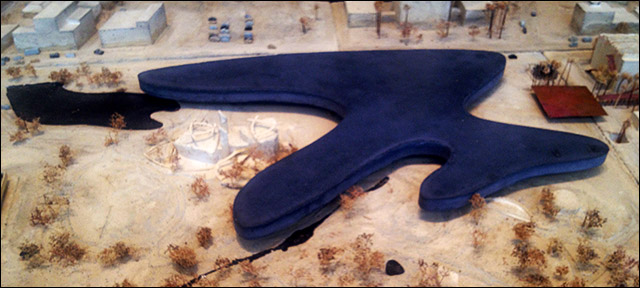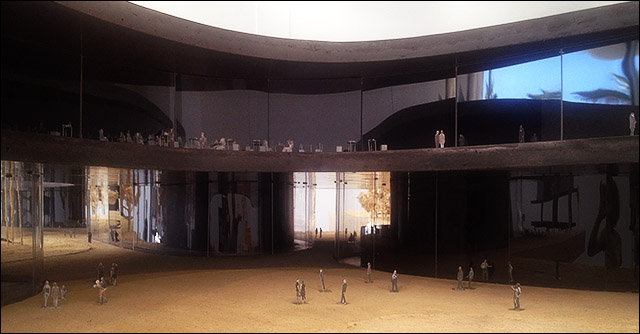art
Can a Museum Curate Itself?
Architecture, Urban Cultureby Richard Risemberg
July 2013–The Los Angeles County Museum of Art recently announced yet another winner in its seemingly accursed search for a new campus—a search that has been going on for too long now—or perhaps not long enough.
The museum’s original buildings, a gathering of stately if terminally banal colonnaded cubes just west of the famed La Brea Tar Pits, are more reminiscent of 1960s savings & loan branches than a major cultural institution. However, the procession of failed plans to better them has shown that bold vision in and of itself has not sufficed to realize their replacement—especially as, incomprehensible though it seems to many of us, the old marble doilies have their fans.
Over the years, the campus lost its reflective pools to tar intrusions, which provided a handy excuse to add the Anderson building, soon renamed the Arts of the Americas, a strangely eclectic edifice whose cladding alternates a vigorous mingling of marble and glass brick with puzzling iterations of textured white bulges, which rather resemble a towering display of toilet paper in some bigbox store. Nevertheless, a grand Wilshire entrance topped by a glass-and-steel canopy made for a dramatic transition to the courtyard—until LACMA acquired the celebrated Chris Burden “Urban Light” lammpost array and moved the entrance half a block west.
The first attempt at wholesale renovation came in 2001, when Rem Koolhaus declared that the best thing to do was to tear down all the buildings and put the museum underground, with a framed translucent simulacrum of a tent undulating over it all to keep out the rain. Sort of a postmodern version of Queen Victoria’s Crystal Palace. This design was widely hated and went nowhere.
The next starchitect to enter the fray was Renzo Piano, commissioned to “transform” LACMA. What he came up with looked rather like an anorexic aircraft carrier, which sailed into oblivion unmourned. Piano did, however, draw up the very effective and quite handsome Broad and Resnick buildings that now show contemporary art in the west end of the campus. He also closed a street that bisected the campus and replaced it with a pavilion between the old and new buildings, as well as moving the parking underground to make room for the Resnick. Along the way architect Bruce Goff shaped the wonderful Pavilion for Japanese Art.
But now we have Peter Zumthor, who again proposes tearing down the old buildings (which sentiment I share), but, in opposition to Koolhas, putting the new museum in the air….

The “Black Flower” in context; architectural model on display at LAMCA
His proposed replacement could be problematical. Referred to as the “Black Flower,” and alleged to have been inspired by a blob of petroleum oozing from the adjacent Tar Pits, it is perhaps more reminiscent of a freeform 1960’s coffeetable, or perhaps a deranged pirate amoeba. It spreads an undulating black sprawl of pseudopods in all directions around the Tar Pits and the existing keeper buildings, and would stand on eight ovoid glass nacelles through which patrons would enter, and which would hold art, or perhaps snack bars, variously. All vertical surfaces would be dark glass. And yes, in the renderings and models it generates very much the street-level sensation of a cluster of corporate towers, or—worse yet—an airport. While the vast expanse of the building would allow for plenty of solar cells up top, it also would overwhelm park and patrons alike—and its tribute to the region’s “horizontality,” as stated by Zumthor, celebrates LA’s most shameful characteristic, the sprawl that has made our region unsustainable.

How it would look as you walk up to it
Furthermore, the shapes of the nacelles and the spaces they create underneath the great black blob almost ensure a venturi effect that could generate blasting winds when the daily seabreeze kicks in. The widely-separated square buildings on Wilshire already create a milder version of this, as anyone who has walked along the boulevard any time after eleven AM already knows. This would kill pedestrian life under the amoeba—which I suppose makes it very LA, in the wrongest way possible.

Wind could be a problem here; it certainly is on adjacent Wilshire Boulevard between the tall buildings
In short, let’s hope that third time’s NOT the charm here, and that reflection, reconsideration, and yet another architect come up with something better. LAMCA’s collection grows and improves year by year, and it deserves a home that will complement, not compete, with it. And certainly one that embraces, rather than crushes, its park, its neighborhood, and its patrons’ souls.
Text by Richard Risemberg, photos by Gina Morey Risembereg
Five Things You can Do to Make Life More Interesting
LifestyleTired of Facebook? Does a trip to the discount store get you down? Do you feel on the usual side? Do visitors to your home have nothing that screams “you” to notice. You don’t have to settle for all the ordinary things you can click and buy now. Check out these suggestions for changes you can make now to be engaged and make life more interesting.
Things You Can Do To Make Life More Interesting:
1. Find and buy art
You’ve been to a museum, right? Lots of interesting people there. Lots of art too. Guess what, you don’t have to be on the board of a large corporation to buy art. Art is being made by lots of people right around you, and they would benefit from your support. Buying art means engaging with lots of interesting people at galleries, openings and studio tours. There’s no reason to have bare walls- or worse, stuff from Ikea hanging there. Get out there! be confident. Buy what you like. Don’t yet your walls scream “I’m boring.”
2. Switch from files to records and compact discs
You do know its illegal to “share” music files right? Well its still ok to lend a friend a compact disc. Music downloads from the computer leave behind the whole culture of records and record stores. The culture of local music is also often centered around these stores. Plus records and cds come with pictures and lyrics and you won’t lose them if your computer crashes. Most cds and even vinyl records now come with downloads for your portable devices. And you can sell the ones you’re tired of!
3. Replace department store furniture with antiques
Older things, especially those made by hand, give you a lot more to talk about. If they are family pieces, they bring back certain memories. Even if you don’t know much about them, someone else does and that learning venture can be pretty fun. There’s also the story of how you came upon an item, whether it be a fancy show, dusty antique store, roadside flea market or amazing estate sale. There’s just not much to say if you chose it from the Pottery Barn catalog. It’s also a green thing to do, especially if you buy it locally.
4. Add vintage accessories
Dressing in period vintage isn’t for everyone. In fact you may be pegged as downright odd if you don’t pull it off just right. There’s nothing particularly wrong with being odd, but it’s easy to come off as interesting when you accent your outfit with vintage items. This can be anything from a scarf, hat, purse, jewelry belt, belt buckle or even glasses. Yes, you can buy an old pair of glasses and have prescription lenses inserted. The cost savings will allow room for a second or third pair. Think sunglasses.
5. Shop locally, eat locally
I’ve been getting more and more annoyed lately with corporate slogans at stores and restaurants. Are you really glad I am here today? Do you really want me to be well? You can avoid all that by seeking out local stores, and a great place to start is a farmer’s market. Imagine being able to ask questions about vegetables and get answers from the people who grew them! Plus there are often entrepreneurs selling sauces, wine and other items. Each one represents someone’s passion and they are all too happy to share that passion. And you know what? It just may rub off on you.
Urban Alienation, and Community
NewsLogI was just reading the thesis of a Dallas artist named Maryanne Meltzer. Her work dealt with alienation, and her thesis references the work of George Tooker and Edward Hopper. Both depict alienation in urban society, brought on by the industrial revolution. Today I think we see urban life as a respite from the alienation of both suburbia, and of the technology we are increasingly attached to. That is what, in my opinion, is bringing about the current urban renaissance. It’s interesting how city life can breed both alienation and community.



